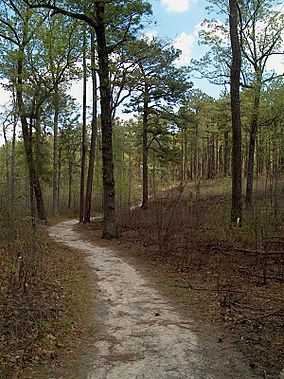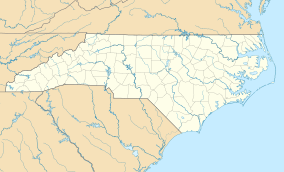Weymouth Woods-Sandhills Nature Preserve facts for kids
Quick facts for kids Weymouth Woods-Sandhills Nature Preserve |
|
|---|---|
 |
|
| Location | Moore, North Carolina, United States |
| Area | 915 acres (370 ha) |
| Established | 1963 |
| Governing body | North Carolina Division of Parks and Recreation |
| Website | Weymouth Woods-Sandhills Nature Preserve |
Weymouth Woods-Sandhills Nature Preserve is a cool state park in North Carolina. It's located in Moore County, near Southern Pines, North Carolina. This special place covers about 915 acres (which is about 3.7 square kilometers). It's part of the unique Sandhills region.
One of the most amazing things about Weymouth Woods is that it's home to the oldest known longleaf pine tree. Scientists have figured out that this tree is 458 years old! Imagine all the history it has seen.
Contents
What are the Sandhills?
The ground at Weymouth Woods and the wider Sandhills area is made of loose sand. This sand was actually blown here by the wind a very long time ago. It happened in different stages, starting around 75,000 years ago and ending about 6,000 years ago. So, when you walk here, you're walking on ancient sand dunes!
A Look Back in Time
Long ago, in the mid-1700s, people from Scotland came to live in the Sandhills. Back then, the forest was full of huge, old longleaf pine trees. These trees could grow as tall as 100 to 120 feet (about 30 to 37 meters)!
How People Used the Pines
Merchants started cutting down these tall trees for timber. They also picked out the best trees to use as masts for the Royal Navy ships. People also collected a sticky sap, called resin, from the longleaf pines. This resin was used to make important products for ships, like tar and pitch. These products helped seal the ships and keep them waterproof.
By the mid-1800s, North Carolina's pine forests were making a lot of these "naval stores" products. The sap was collected from V-shaped cuts in the tree trunks. It was then turned into things like turpentine, which was used as a cleaner and for lamps. Tar, pitch, and rosin were used to protect the wooden parts of sailing ships.
When railroads arrived in the 1870s, it became much easier to cut down and move lots of trees. Because of all this logging, most of the original, very old longleaf pines were gone by 1900. If you look closely at some of the older trees that are still around today, you might see scars from where people collected their sap.
Saving the Forest
In the early 1900s, a man named James Boyd's grandfather bought a large piece of land. He wanted to save the longleaf pines from being cut down. He named his property Weymouth because the pine trees reminded him of trees in Weymouth, England.
Later, in April 1963, James Boyd's widow, Katharine, gave 403 acres (about 1.6 square kilometers) of this land to the state. This gift created the very first natural area in the North Carolina state parks system. More land has been added since then, making the preserve even bigger.
Amazing Animals in James Creek
A stream called James Creek flows through the preserve. This creek is a special place for some rare fish! It's home to the mud sunfish and the sandhills chub. The sandhills chub is a fish that only lives in the Sandhills region.
Unique Fish Species
You can also find brown bullhead and bluegill fish in James Creek. It's also one of the northernmost places where you can find the dollar sunfish. James Creek is a "blackwater" creek. This means its water is dark and stained by natural plant materials, like tea. This creates a unique environment where special species can thrive.
Explore the Museum!
The preserve has a visitor center with an exhibit hall. This museum teaches you all about the natural history of the longleaf pine forest. You can learn about the geology of the area, the different plants and animals that live there, and how prescribed fires are used to keep the forest healthy.
Learning About Nature
One exhibit shows how pine resin was used in the old "naval stores industry." The museum is open every day. Park naturalists also lead fun environmental education programs for families and school groups. It's a great way to learn more about this special place!



